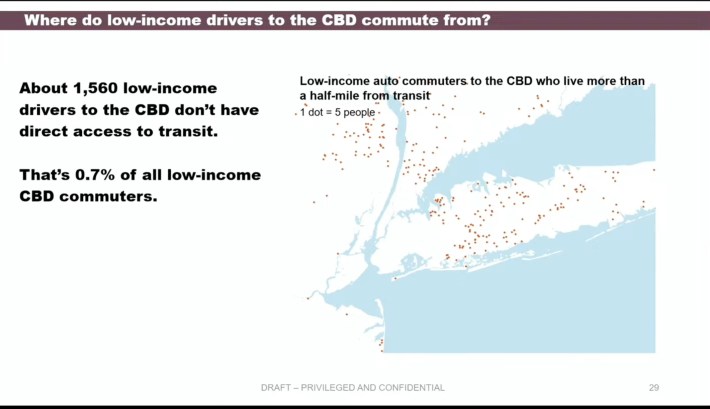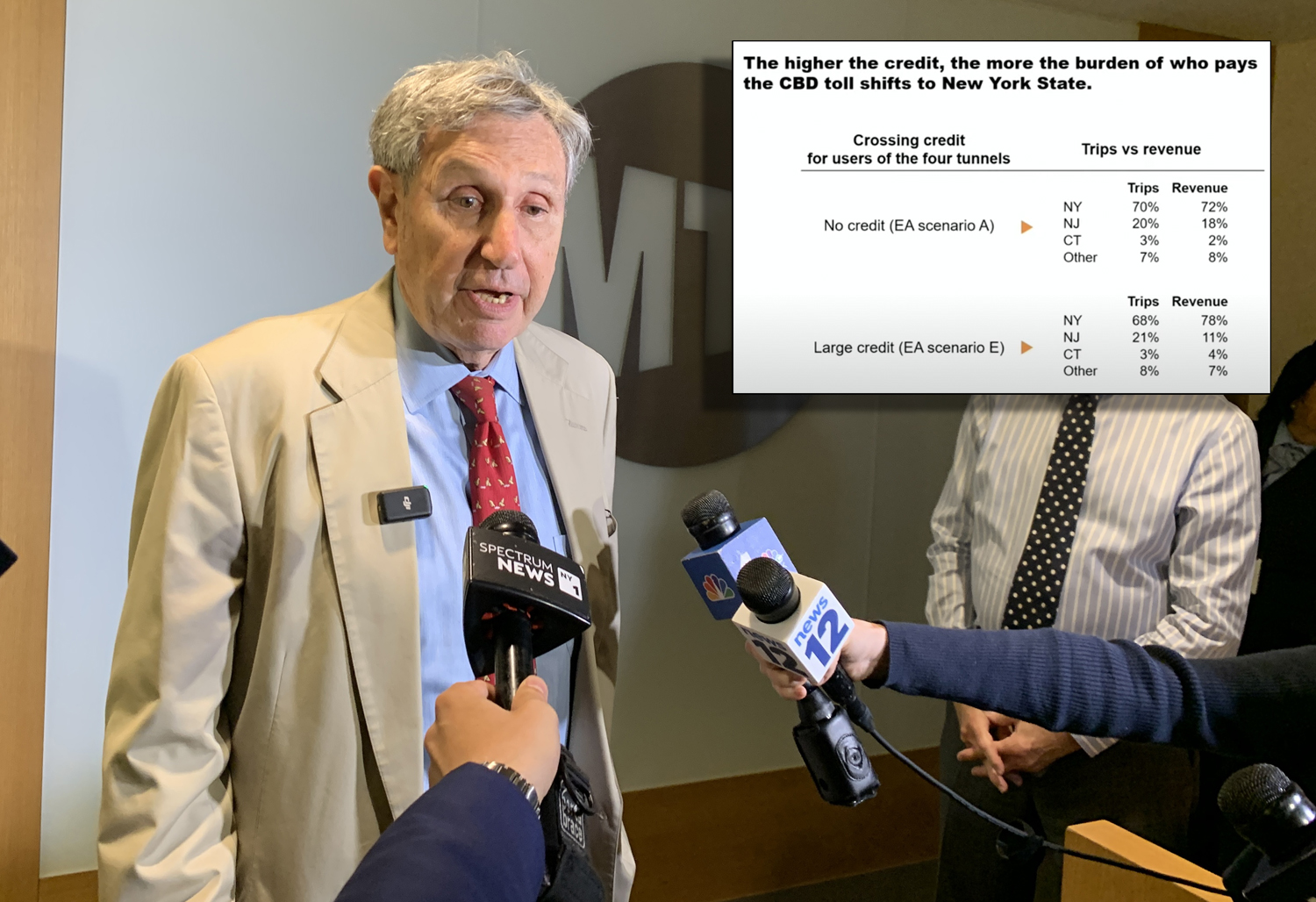New York drivers would have to shoulder a greater share of the cost of congestion pricing — and more motorists would come into the Big Apple from New Jersey — if transit officials give congestion toll discounts to people using existing tunnels, the Metropolitan Transportation Authority revealed yesterday.
Drivers coming to Manhattan via the Holland, Lincoln, Queens-Midtown, and Hugh Carey tunnels already pay about $14 round trip, and the MTA has floated proposals to give those motorists a crossing "credit" against the toll to enter the central business district below 60th Street. But those markdowns would shift the burden to generate $1 billion in needed annual revenue to the Empire State.
Depending on the size of the credit and, of course, the eventual size of the congestion toll, New Jerseyans would have to pay just a little or no more than they currently do to drive their gas guzzlers into the most transit-dense and congested part of country. But any credit would shift the burden to non-tunnel users.
MTA experts presented how the credits would affect the price of the congestion charge and traffic patterns on Thursday to the Traffic Mobility Review Board, the six-member panel that is tasked with recommending exemptions or discounts. All but one member of the panel were appointed by Gov. Hochul.
The daily charge to drive below 60th Street will be somewhere between $9-$23, but any tunnel credits will raise the fee for everyone else because the MTA has to make $1 billion a year under the state law that created congestion pricing in 2019. The revenue will unlock $15 billion in bonds to pay for capital upgrades over five years.
The credits may be appealing to New Jersey politicians who have beaten the drum against congestion pricing for years, slamming it as “double taxation,” since they already pay tolls to drive into New York City, and the state’s governor, Phil Murphy, even sued the federal government to block the proposal.
MTA reps made clear that it's not that simple.
Without any crossing credits, drivers going to downtown Manhattan from New Jersey or from the two East River tunnels would have to pay the regular congestion charge on top of the toll. With the rebates, their charge could be lowered to be the same level as motorists going to the central business district from anywhere else.
But giving tunnel drivers that credit would reshuffle which drivers decide to pay the toll and contribute to the $1-billion-a-year pot, said Juliette Michaelson, MTA’s special adviser to the TMRB.
“Everyone driving into the CBD would pay the same amount in tolls in total, no matter how they enter the CBD, but some drivers would be contributing much less than other drivers for the congestion they cause in the central business district,” said Michaelson.
New Jersey's contribution to congestion pricing revenue would drop from 18 percent to 11 percent, even though its drivers would account for 1 percent more car trips than without the credit.
Meanwhile, New Yorkers would have to account for 6 percent more revenue than without credits, while driving less often into the zone. As the MTA chart below shows, no tunnel credit is the most equitable plan because the revenue generated by each type of driver more or less mimics how many trips are made by said drivers. A large tunnel credit skews the numbers.

The credits could also divert an additional 3,400 trucks, who would avoid the congestion zone, some five percent of all trucks going into the CBD, Michaelson added.
The analysis also showed how each incremental crossing credit would have to be made up by charging everyone else more, so the MTA can still raise $1 billion a year. However, economist Charles Komanoff doubted MTA's calculations of the impact on the general toll.
Not a hill to die on. It's nonsensical that tunnel credits could be so impactful, numerically. Happy to show you w/ my model. Plus, charging full CP toll on E Riv tunnels will perpetuate toll-shopping. And there's basic fairness to consider as well. Please rethink.
— Charles Komanoff (@Komanoff) August 17, 2023
The TMRB is the body in charge of recommending the congestion toll as well as doling out exemptions and credits. The panel's chairman told reporters that the committee will have to find a middle ground when it comes to credits.
“You could see that if we had, you know, zero crossing credit, it would be a pretty stiff price on everybody, and if we had the maximum crossing credit, it would also be skewed the other way very badly. So, you know how we balance that,” Carl Weisbrod told reporters at MTA headquarters after the TMRB’s meeting.
The board's second meeting following its disorganized debut last month included sympathetic speeches from several members about the tiny number of low-income commuters who drive into the CBD because they don't live near transit— which some members latched onto to push for more discounts.
Some 1.5 million people work in the area below 60th Street, but a whopping 1.3 million commute there by transit, nearly nine in 10. The number of drivers who earn below $50,000 and live in a transit desert is just 1,560 people.
Almost all of them live in the suburbs, since in the city only Breezy Point at the edge of Queens qualified as a transit desert — which the MTA defines as areas where residents are more than one-half mile from a bus, subway, or commuter rail stop.

Chief of External Relations John McCarthy tried to steer the conversation back to the vast majority of regional residents. “If there was a map of the low-income non-drivers, we would have a lot more red dots,” he said by way of explaining that the overwhelming number of commuters arrive to the CBD via transit. And the majority of those who chose to drive tend to be wealthier.
Nevertheless, several panelists honed in on the minuscule fraction of commuters, which makes up 0.1 percent of people working in the central business zone.
“We really should look to alleviate some of the burden of congestion pricing on low-income drivers that need to drive with frequency into CBD as employees as small business owners and alike,” said Elizabeth Velez, who heads an eponymous construction company and also sits on the MTA board.
Mayor Adams’s sole board rep, Transport Workers Union International President John Samuelsen, said the agency should give low-income drivers better transit before saddling them with charges.
“If you’re a low-income driver and you’re on the outer fringes of the outer boroughs … you’re now going to incur childcare costs on folks that can’t afford it, you’re going to put another perhaps two hours on their commute, childcare costs, all the other costs that low-income people can’t afford to begin with, and really in areas where there is no viable subway option,” he said.
But addressing the concerns of low-income drivers is "just a piece of what we have to do here," Weisbrod later said.
The TMRB will reconvene for a third hearing at a to-be-determined date, Weisbrod added.






